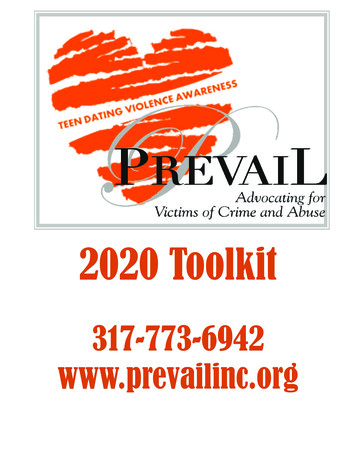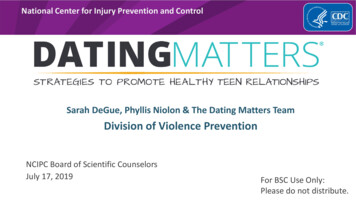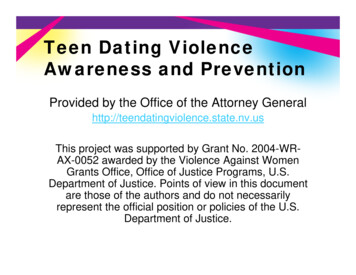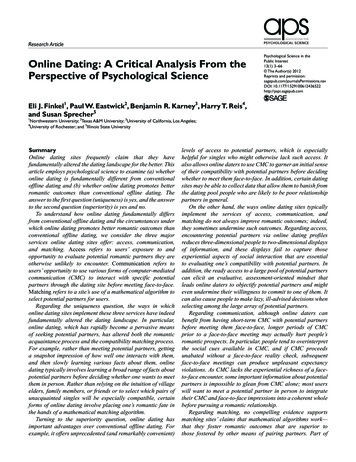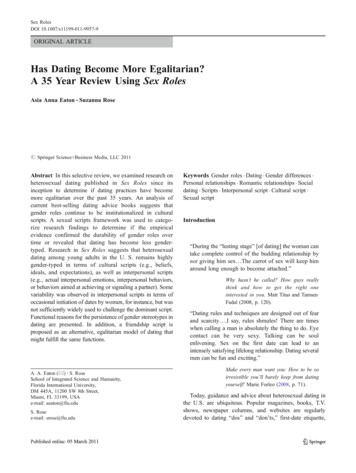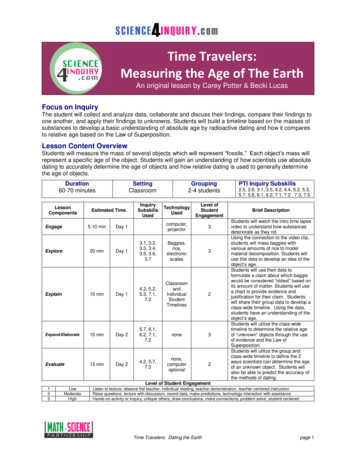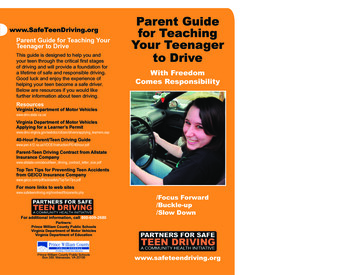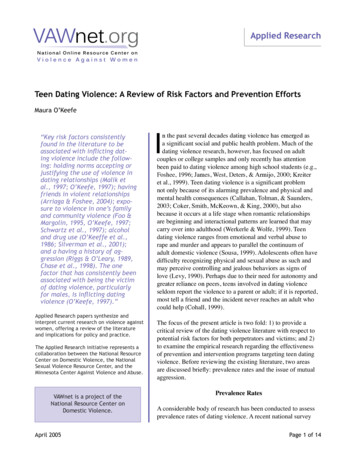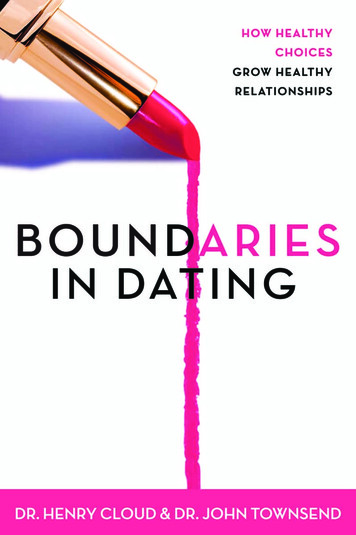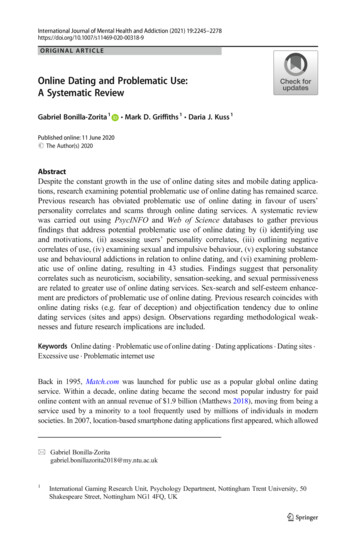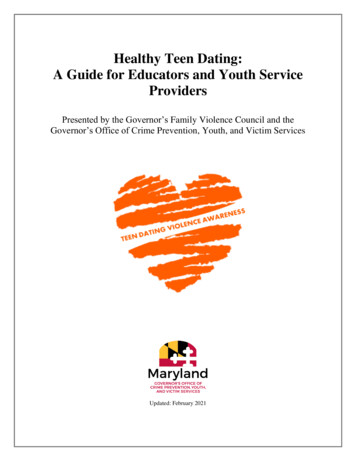
Transcription
Healthy Teen Dating:A Guide for Educators and Youth ServiceProvidersPresented by the Governor’s Family Violence Council and theGovernor’s Office of Crime Prevention, Youth, and Victim ServicesUpdated: February 2021
A Message from Governor Larry HoganDear Educators and Youth Serving Professionals,I am pleased to present the Healthy Teen Dating: A Guide forEducators and Youth Serving Professionals.In 2016, the Governor’s Family Violence Council voted tocreate a workgroup to study ways to bring healthy teen datingeducation to all Maryland counties. The purpose of this guide isto provide information on teen dating violence preventionprograms to address the needs of youth who are at risk fordating violence. Each year, nearly 1.5 million high schoolstudents nationwide experience physical abuse from a datingpartner. In 2014, more than 10 percent of Maryland high schoolstudents reported experiencing physical and/or sexual datingviolence.This guide contains relevant data and literature, educational resources, and suggested curriculumon teen dating violence which aligns with Maryland State Education Standards. You will alsofind a list of teen dating violence prevention programs in the state to help you connect the youthyou serve with agencies that can best help them.Our hope is that this guide will be a valuable resource for you to provide teen dating violenceprevention support to our teens in need. In doing so, we can prevent future violence and fosterhealthy relationships within our schools and communities.Sincerely,Larry HoganGovernor1
The Goal of this GuideIn 2016, the Governor’s Family Violence Council voted to create a workgroup to study ways tobring healthy teen dating education to all counties in the State. The workgroup looked at bestpractices and evaluated whether a statewide approach to this issue would increase awareness andeducation. The workgroup considered ways to engage public and private middle and highschools in this prevention effort.As a part of the information-gathering process, the workgroup surveyed Maryland localeducation agencies (LEAs) to understand current school offerings and potential barriers. Of the24 LEAs in Maryland, 19 responded to the survey. While the majority stated that their LEAoffered some healthy relationship curriculum, few described stand-alone, focused education onthis topic.Of those surveyed, 84% of respondents stated they believed that teen dating violence educationwas important to offer in schools, but respondents described numerous barriers toimplementation:BarriersTime3%9%Resources ( )15%46%Lack of MaterialsNone27%CommunityResistanceFigure 1: Self-reported barriers to providing TDV education in schoolsThis resource guide was created to address these barriers by providing low cost or free optionsfor classroom implementation that maximize impact even where limited time is available in thecurriculum.2
The Prevalence and Impact of Teen Dating ViolenceWhat is teen dating violence?Teen dating violence (TDV) is the physical, sexual, psychological, or emotional violence withina dating relationship, including stalking.1,2,3 TDV can include any pattern of behavior that aperson may use to gain and maintain power over their partner.4 This can include financial abuseand digital abuse. Digital dating abuse is the use of technology (i.e. texting, social networks) toharass, stalk, or intimidate a partner.5 Digital abuse often takes the form of psychological oremotional violence.6How common is TDV?National estimates of TDV victimization depend on various demographic factors, with femalestudents reporting TDV close to two times more often than their male counterparts.7 Nearly 1.5million high school students nationwide experience physical abuse from a dating partner in asingle year.8Overall, one in three females and one in seven males report experiencing TDV.9 And one in fiveadolescents reported physical TDV and roughly one in ten reported sexual TDV.10TDV Prevalence25Percent20151050Any TDVPhysical TDVMaleSexual TDVFemaleFigure 1: Prevalence of TDV by type and gender11In Maryland, 10.1% of high school students reported experiencing physical dating violence and10.3% reported experiencing sexual dating violence.12Who is at highest risk?TDV occurs in higher rates among Black and Latinx youth, including those living in urban andeconomically disadvantaged communities.13 One study found that the prevalence of TDVvictimization among Black and Latinx youth was 41%.14 About 30% of the youth in this studyreported both victimization and perpetration in current or past relationships.153
Recent research looked at risk based on gender. One study determined that females are equally aslikely as males to perpetrate TDV, especially with minor acts of physical aggression.16 The studyalso found that female-on-male aggression is often underreported due to issues of stigma andmasculinity.17Lesbian, gay, bisexual, transgender, questioning (LGBTQ) youth are also at a higher risk for alltypes of dating violence victimization and perpetration, when compared to heterosexual youth.18Specifically, transgender and female youth are at the highest risk of victimization andperpetration of TDV.19Older teens are at an increased risk of sexual TDV victimization.20Why does TDV happen?Teens learn how to behave in relationships from peers, adults, and the media. Unfortunately,these examples often suggest that violence in a relationship is normal. According to the Centersfor Disease Control (CDC) the risk of having unhealthy relationships increase for teens who: Believe that dating violence is acceptableAre depressed, anxious, or have other symptoms of traumaDisplay aggression towards peers or display other aggressive behaviorsUse drugs or illegal substancesEngage in early sexual activity and have multiple sexual partnersHave a friend involved in dating violenceHave conflicts with a partnerWitness or experience violence in the home21What are the warning signs of TDV?22Teen dating violence often exists on a spectrum. The following are some warning signs torecognize TDV: Checking his/her cell phone or email without permissionConstantly putting him/her downExtreme jealousy or insecurityExplosive temperIsolating him/her from family or friendsMaking false accusationsMood swingsPhysically hurting him/her in any wayPossessivenessTelling him/her what to doPressuring or forcing him/her to have sexClick here to learn more about how unhealthy relationships work.4
How does TDV impact health?Unhealthy or violent relationships can have severe short and long-term effects on a teen’sdevelopment.23 Youth who have experienced TDV are at a higher risk of experiencing thefollowing: DepressionAnxietyIncreased use of alcohol, tobacco, and drugsRisky sexual behaviors: unprotected sex, pregnancy, multiple sex partners, STIs 24,25Eating disorders26Thoughts of suicideYouth who experience TDV are at an increased risk of re-victimization in college and adulthood.Moreover, youth who experience TDV are roughly 2 to 3 times as likely to attempt suicide.27Taking TDV Prevention to the ClassroomTDV prevention programs reduce violenceTDV can be prevented when teens, parents, schools, and communities work together toimplement evidence-based prevention strategies.28 School-based dating violence preventionprograms have shown to be effective in preventing physical, sexual, and emotional violence inadolescent dating relationships and may help prevent violence in adult relationships as well.29Students weigh-in on effective programsBased on focus group and survey research, middle and high school students reported greatersatisfaction with TDV prevention programs that had:30,31 Mix-gendered activitiesMentoring from trusted adults or older adolescentsA focus on personal development of values (love, respect, self-esteem, etc.)Used real-life stories of TDV, followed by clear presentation of informationIncluded information about characteristics of healthy relationshipsMaryland State Education Standard AlignmentIncluding teen dating violence curriculum meets several of the Health Education standardsprovided by the Maryland State Board of Education.Standard 1: Mental and Emotional Health Topic A, Communication: Recognize and apply effective communication skills Topic D, Decision Making: Apply the decision-making process to personal issues andproblems5
Topic G, Conflict Resolution: Justify the nature of conflict and conflict resolutionStandard 4: Family Life and Human Sexuality Topic D, Healthy Relationships: Distinguish between healthy and unhealthy relationships Topic J, Sexuality and Culture: Evaluate the influence of communication and decisionmaking on sexual behaviorStandard 5: Safety and Injury Prevention Topic C, Harassmento Indicator 1: Demonstrate appropriate responses to harassment and other violentbehaviorso Indicator 2: Recognize contributors to harassment, intimidating behaviors, andviolence Topic D, Abuse and Assault: Assess and respond appropriately to sexual aggressionEvaluating Effective ProgramsResearch has demonstrated that effective prevention programs follow certain principles.32Effective programs:1.2.3.4.5.6.7.8.9.Are comprehensiveUse varied teaching methodsOffer sufficient dosageAre theory drivenEncourage positive relationshipsAre appropriately timedAre socio-culturally relevantInclude outcome evaluationAre implemented by well-trained staffThe CDC and other agencies provide tools to help develop, evaluate, and sustain a public healthapproach to preventing teen dating violence. Several of these resources are provided below:CDC Capacity Assessment and Planning ToolCDC Health Education Curriculum Analysis Tool (HECAT)CDC School Health Index6
Teen Dating Violence Prevention ProgramsThe following list is not intended to be comprehensive, but instead to provide a menu of possible options. Formore information, please consult the website associated with the individual program. Please provide feedbackto the Governor’s Family Violence Council as described on page 12 of this guide.NameDescriptionAmatus RecoveryCenters“With All Due Respect” preventionprogram helps students define andcultivate healthy relationships, identifyred flags for abusive relationships,implement critical thinking skills,evaluate costs as it relates to decisionmaking, and create an ongoing,personalized plan that can be utilizedthroughout adolescence in preparationfor adulthood.Athletes on girls’ sports teams will beempowered to take an active role inpromoting healthy relationships, endingsexual violence, and to be leaders inchanging social norms to a culture ofsafety and respectStudents engage with true-to-lifescenarios that include bystanderintervention strategies and positiverelationship examplesContact: ChelseaNelson-Dorsey, 410807-8471Athletes as LeadersCharacter Playbook Building HealthyRelationshipsCenter for AbusedPersonsContact: AnnetteGilbert-Jackson, 301645-3336Chesterfield RELATEChoose RespectCitizens Assisting andSheltering the Abused,Inc.Coaching Boys intoMen Length ofTime90 minsEvidence ofEffectivenessPost surveys hasshowedincreased abilityto define teendating violenceand increasedability to identifysigns of anunhealthyrelationshipUses researchand bestpractices ofsexual assaultpreventionCostFreeHigh schoolUses evidencebased strategies,but no studies oneffectiveness ofCharacterPlaybook havebeen conductedNo publishedstudies oneffectivenessFreeMiddleschoolFreeHigh schoolIncreasesknowledge abouthealthyrelationships33No publishedstudies oneffectiveness 225High school 32- 125MiddleschoolVariesNo publishedstudies oneffectivenessFreeMiddle andhigh tration andnegativebystanderactivities34FreeHigh schoolmaleathletes10 sessions2-3 hours(online)Educational seminars anddissemination of information on topicsincluding healthy relationships anddrug-facilitated sexual assault forCharles County schoolsVariesPeer-facilitated lessons include:lectures, skits, activities and selfassessmentFive 1-hoursessionsCampaign resources that reach out toadolescents, ages 11 to 14, andconnects with parents, teachers, youthleaders, and other caregiversWorkshops address topics such as selfesteem domestic violence, familyviolence and sexual assault forWashington County schoolsSeries of coach-to-athlete trainings thatillustrate ways to model respect andpromote healthy relationshipsN/A7FreeTargetAudienceMiddle andhigh school;incarceratedyouth up toage 21
NameDescriptionCrisis InterventionCenterOffers healthy relationship program toCalvert County public school studentsDating Matters Educator TrainingCDC-developed training about TDVthat provides knowledge and resourcesfor educatorsHealthy relationship tool that engagesyouth and adults to explore theirpersonal values, discern character traitsof others, practice decision makingA school outreach counselor is colocated at the schools in Garrett Countyto present annually for 7th and 9thgrade health classes to help changeattitudes and social norms that supportdating and sexual violenceProgram focused on legal issues:includes a self-guided resource forstudents, a video presentation foradults, and classroom materials60 minsManual includes curriculum for supportgroups, lessons, and school-wideprevention strategiesSupportgroups: 24sessionsDiscovery DatingDove CenterContact: HeatherHanline, 301-334-6255Ending Violence: Breakthe Cycle Expect Respect Length ofTimeVariesVariesVaries3 classsessions(45-60mins each)SafeTeenslessons: 8Expect RespectMontgomery CountyContact: Smita Varia,smita.varia@montgomerycountymd.govFamily Crisis ResourceCenterContact: Sarah Kaiser,301-759-9244Florida CoalitionAgainst DomesticViolenceThe Fourth “R” Evidence ofEffectivenessNo publishedstudies oneffectivenessNo publishedstudies oneffectivenessIncreasesstudents’ senseof personalagency35,36No publishedstudies oneffectivenessCostFreeTargetAudienceMiddle andhigh schoolFreeMiddleschoolVariesMiddleschoolFreeMiddle andhigh schoolIncreasesknowledge ofdating violencelaws; decreasesacceptance offemale-on-maleviolence;increaseslikelihood ofseeking help37Increasesknowledge abouthealthyrelationships andwarning signs ofTDV; increaseshealthy conflictresolution38Uses evidencebased strategiesbut no studies oneffectivenesshave beenconductedNo publishedstudies oneffectiveness 108https://www.hazelden.org/OA HTML/ibeCCtpItmDspRte.jsp?item 195106High school;effective forLatinx youth 160Middle andhigh school;supportgroups for atrisk youthexposed toviolenceFreeMiddle andhigh schoolFreeMiddle andhigh schoolStudents learn about dating violence,consent, warning signs and how to helpa friend45 minsA girls’ empowerment group, healthymasculinity group and LGBTQ groupwithin Allegany public school settingsare offered to prevent dating and sexualviolenceProvides fundamental knowledge tostudents about teen dating violenceVariesEight 45minsessionsNo publishedstudies oneffectivenessFreeMiddle andhigh schoolAims to reduce youth dating violenceby addressing youth violence andbullying, unsafe sexual behavior, andsubstance useVariesReduction inphysical datingviolence duringprevious year39 35-300Middle andhigh school8
NameDescription#healthyfriendships Experiential workshop usingicebreakers, creative brainstorming,and role-play; students learn to identifysigns of unhealthy friendships and usetools to help themselves or a friendHeartly House, Inc.Educational seminars for youth andyouth-serving professionals inFrederick County on pro-social norms,healthy relationships, bystanderintervention, and consentProgram provides psycho-educationalintervention/prevention classes for teenperpetrators of teen dating violence andteens who have been affected bydomestic violence and/or sexualassault; these classes promote offenderaccountability and responsibility andteach skills for maintaining a healthy,respectful and violence freerelationship; topics include consent,red-flags, conflict resolution,maintaining healthy boundaries, genderrole stereotypes, definitions of abuse,sexual harassment and sexual abuse;utilizes the Live Respect curriculumand other evidence-based strategiesService-learning program promotinghealthy relationships, behaviors andattitudes to inspire introspectivethinking, social consciousness and theuse of concepts to reduce violenceParticipants assume the role of acharacter who is in an abusiverelationship or is witnessing one andlearn how to identify red flags of datingabuse, who to talk to, and how to help afriendLessons that aim to modify cognitions(dating attitudes, expectations, andknowledge) and behaviors (conflictresolution, and communication skills)to help students foster healthyrelationshipsVariesLessons on healthy relationships,identifying red flags, how to helpsomeone who they feel is in danger,domestic violence, sexual assault andrelated topicsVariesContact: Nina Carr,ncarr@heartlyhouse.orgHERO (Healthy EqualRelationship Options)HopeWorks YouthLeadership InitiativeIt’s Not Love Katie BrownEducational Program Contact: ClaireMcVicker,csmcvicker@kbep.orgLife Crisis CenterContact: Donna Leffew,dleffew@lifecrisiscenter.org9Length ofTime75-90 minsEvidence ofEffectivenessUses evidencebased strategies,but no studies oneffectivenesshave beenconductedNo publishedstudies oneffectivenessCostFreeMiddle andhigh school2 hourweeklygroupsessions fora minimumof 20weeks; canbemodifiedfor victimor use inschoolsettingUses evidencebased strategiesbut no studies oneffectivenesshave beenconductedVariesHigh schooland youngadultRequiresmonthlymeetingsandtrainingsPart I andII: 75-90mins eachNo publishedstudies oneffectivenessFreeHigh schoolUses evidencebased strategies,but no studies oneffectivenesshave beenconductedLower approvalof aggression,healthier datingattitudes; lessemotional/verbal and totalDV perpetrationandvictimization40No publishedstudies oneffectivenessVariesHigh schoolVariesMiddle andhigh schoolFree toSomerset,Wicomico,WorcesterCo. PublicSchoolsMiddle andhigh schoolFive 50-60minsessionsVariesTargetAudienceMiddleschool
NameDescriptionMarriage &Relationship EducationCenterClassroom and virtual presentationsthat empower students to make healthydecisions; provide tools and resourcesto create healthy relationships; increaseprotective factors and positive assets(eg. communication skills, financialliteracy) to help students avoid riskybehavior and cope with new challengesFilm and discussion-based curriculumsurrounding preventative education onhealthy and unhealthy relationship;useful free tools and resources onwebsiteContact: Amy Gilfordamy@mrecenter.orgOne LoveContact: ince George’s CountyDepartment of FamilyServices, DomesticViolence and HumanTrafficking DivisionLength ofTimeVariesEvidence ofEffectivenessUses evidencebased curriculawhich hasproven effectivethrough rigorousevaluationCostVariesIncreasedknowledge onrecognizinghealthy andunhealthybehaviors asabuse, victimand bystanderSee Safe DatesVariesMiddle andhigh schoolFreeMiddle andhigh schoolFree toCarrollCountyPublicSchools 10-75Middle andhigh schoolVariesTargetAudienceMiddle &HighSchool, andyoung adultpopulationsProgram provides Safe DatesCurriculum to youth, as well asfacilitator trainingFour to ten50 - minutesessionsClassroom presentations in CarrollCounty cover child sexual abuse,date/acquaintance rape, sexual anddating violence, domestic violence andsexual harassmentDidactic presentations, modeling, roleplays, experiential exercises, anddiscussion about sexual harassment,gender roles, and physical violenceVariesNo publishedstudies oneffectiveness5 UnitsEffective inincreasingknowledge andimprovingattitudes41Safe DatesProgram includes lessons, 45-minuteplay to be performed by students, and aposter contest; program involves familymembersNine 50minutesessions 245Sexual Assault/SpouseAbuse Resource CenterEducational seminars are offered tomiddle and high school students atpublic schools in Harford County;topics include healthy relationships andbystander interventionTwo-part intervention (classroom andschool wide) that highlightsconsequences of behaviorVariesDecreasedphysical andsexualviolenceperpetration andvictimization42No publishedstudies oneffectivenessFreeMiddle andhigh schoolMixed results,but reductions insexual violenceand TDV insome studies43FreeMiddleschoolContact: NatashaHutton,nahutton@co.pg.md.usRape CrisisIntervention ServiceReaching and TeachingTeens to Stop ViolenceShifting Boundaries106 lessons:taught over6-10 weeksMiddle andhigh school;effective forlow-income,minorityyouthMiddle andhigh school
NameDescriptionSpringboardCommunity ServicesProgram educates teens on healthyrelationships and dating violence toencourage boundary setting,communication and safety planning toidentify red flags and risk factors;student support groups on teen datingviolence and healthy relationships arealso availableReceive tools to promote healthyrelationships and learn warning signsStart TalkingTeen ChoicesThat’s Not Cool TurnAround, Inc. Victim Assistance andSexual Assault ProgramYWCA of Annapolis &Anne Arundel CountyOnline program that deliversassessments and individualizedguidance matched to dating history,dating violence experiences, and stageof readinessThat’s Not Cool’s interactive website,tools, Respect Effect app, and resourcessupport youth as they learn torecognize, avoid, and prevent TDVPrograms on healthy relationships andsexual harassment are offered formiddle school students and healthyrelationships and teen dating violenceprograms are offered for high schoolstudents in Baltimore County andBaltimore CityEducational seminars are provided to10th grade health classes inMontgomery County on sexual assaultprevention, to include media violence,social norms that support violence,gender norms and consequencesCommunity education and outreach isprovided to schools to ensureindividuals know the signs of abuse andhow to respond11Length ofTimeVaries,generallyone classsession aquarterEvidence ofEffectivenessNo publishedstudies oneffectivenessCostTen 40minutesessionsLowers tolerancefor abuse andincreasesknowledge ofhealthybehaviorsReduction indating violence(physical, sexual,psychological,and emotion)44No publishedstudies oneffectivenessVariesMiddleschool 500High schoolFreeMiddle andhigh school30-60 minNo publishedstudies oneffectivenessFreeMiddle andhigh schoolVariesNo publishedstudies oneffectivenessFreeHigh schoolVariesNo publishedstudies oneffectivenessFreeMiddle andhigh school3 sessions(30 minseach)N/AFreeTargetAudienceMiddle andhigh school
AcknowledgementsThe Governor’s Family Violence Council (FVC) thanks Roma Shah, Johns Hopkins School ofPublic Health, MPH/MSW 2019, and the Baltimore Action Project Program at the JohnsHopkins School of Public Health, for the many hours that Ms. Shah spent on this project. TheFVC also thanks our workgroup members for their dedication and hard-work.Glossary of TermsTDV: teen dating violenceSexual TDV: unwanted or forced sexual activity; including forced intercourse, touching,fondling, etc.Physical TDV: includes slapping, hitting, kicking, or beatingPsychological/Emotional TDV: include intimidation, constant belittling, isolating, monitoring,and humiliation,Victimization: experiencing one or more forms of teen dating violencePerpetration: performing or carrying out a form of teen dating violenceLatinx: gender neutral term referencing Latin American cultural or ethnic originFeedback RequestedTo ensure that this guide is relevant and useful, the FVC asks users to please send feedback to:Rebecca AllynGovernor’s Office of Crime Prevention, Youth, and Victim Services100 Community PlaceCrownsville, MD 21032Rebecca.allyn@maryland.gov410-697-9384*Please let us know if you utilize a program listed in this guide and whether you found it tobe effective with your student population.*If you utilize a program that is not listed, please provide us with information so that wecan share your program with other educators and youth service providers.Note on UseThe list of resources contained in this document is not meant to be an exhaustive list but rather aguide of low-cost or free solutions that maximize impact within limited time periods. TheGovernor's Office of Crime Prevention, Youth, and Victim Services is not endorsing theseprograms and encourages school systems to research and evaluate each one individually todetermine the best fit.12
Referral ResourcesNational HotlinesNational Domestic Violence Hotline: 1-800-799-SAFE (7233)National Sexual Assault Hotline: 1-800-656-HOPE (4673)National Dating Abuse Helpline and Love is Respect: 1-866-331-9474 or text loveis to 22522National Sexual Assault Online Hotline: online.rainn.orgMaryland HotlinesMaryland Coalition Against Sexual Assault: 1-800-983-7273Maryland Network Against Domestic Violence: 1-800-MD-HELPSSexual Assault Legal Institute: 301-565-2277211 Maryland: 2-1-1Local Resources by CountyAllegany CountyFamily Crisis Resource Ctr146 Bedford StreetCumberland, MD 21502Hotline: 301-759-9244Office: org/Anne Arundel CountyYWCA of Annapolis & AnneArundel County1517 Ritchie Hwy, Suite 101Arnold, MD 21012Hotline: 410-222-6800Office: e CityCHANAHelpline: 410-234-0023Office: 410-234-0030http://chanabaltimore.org/House of Ruth Maryland2201 Argonne DriveBaltimore, MD 21218Hotline: 410-889-7884Office: 410-889-0840Legal: 410-554-8463http://www.hruth.org/TurnAround, Inc.1800 N. Charles St, Suite 404Baltimore, MD 21218Helpline: 443-279-0379Office: 410–837-7000https://turnaroundinc.org/Baltimore CountyCounty-wide Hotline:410-828-6390Family Crisis Center ofBaltimore County, Inc.P.O. Box 3909Baltimore, MD 21222Hotline: 410-828-6390Office: 410-285-4357Shelter: nAround, Inc.8503 La Salle Road, 2nd Fl.Towson, MD 21286Hotline: 443-279-0379Office: 410-377-8111https://turnaroundinc.org/Calvert CountyCrisis Intervention CenterP.O. Box 980Prince Frederick, MD 20678Hotline: health/crisisintervention/Caroline, Dorchester, Kent,Queen Anne’s and TalbotCountiesFor All Seasons, Inc.300 Talbot StreetEaston, MD 21601Hotline: 410-820-5600Office: 410-822-1018www.forallseasonsinc.org13Mid-Shore Council on FamilyViolence8626 Brooks Dr., Suite 101Easton, MD 21601Office: 410-690-3222Hotline: 1-800-927-4673http://mscfv.org/Carroll CountyRape Crisis Intervention Service224 N Center St., #102Westminster, MD 21157Hotline: 410-857-7322Office: rd CommunityServices22 North Court StreetWestminster, MD 21157Hotline: 443-865-8031Office: 410-876-1233https://www.springboardmd.org/Cecil CountyCecil County DomesticViolence/Rape Crisis CenterP.O. Box 2137Elkton, MD 21922Hotline: 410-996-0333http://www.cecilhelp4u.com
Charles CountyCenter for Abused Persons2670 Crain Hwy, Suite 303Waldorf, MD 20601Hotline: 301-645-3336Office: lescounty.orgFrederick CountyHeartly House, Inc.P.O. Box 857Frederick, MD 21705Hotline: 301-662-8800Office: 301-418-6610https://www.heartlyhouse.orgGarrett CountyThe Dove Center882 Memorial DriveOakland, MD 21550Hotline: 301-334-9000Office: 301-334-6255http://www.gcdovecenter.org/Harford CountySexual Assault /Spouse AbuseResource Center20 N Main StreetBel Air, MD 21014Hotline: 410-836-8430Office: 410-836-8430https://www.sarc-maryland.org/Howard CountyHopeWorks of Howard County9770 Patuxent Woods Dr., Suite300Columbia, MD 21046Hotline: 410-997-2272Office: ry CountyVictim Assistance and SexualAssault Program1301 Piccard Dr., Ste. 4100Rockville, MD 20850Hotline: 240-777-4357Office: program/BHCS/VASAP/VASAPVolDon.htmlJewish Coalition AgainstDomestic AbuseP.O Box 2266Rockville, MD 20847Helpline: 1-877-885-2232Office: 301-315-8040https://jcada.orgFamily Justice Center600 Jefferson Plaza, #500Rockville, MD 20852Hotline: 240-777-4000Office: /Prince George’s CountyDomestic Violence and SexualAssault Center3001 Hospital DriveCheverly, MD 20785Hotline: 301-618-3154Office: mestic-violence-andsexual-assault/Community Crisis Services3601 Taylor StreetBrentwood, MD 20722Hotline:301-731-1203Office: ly Justice Center14757 Main StreetUpper Marlboro, MD 20772Office: ce George’s CountyDepartment of Family Services,Domestic Violence and HumanTrafficking Division6420 Allentown RoadCamp Spring, MD 20748Office: 1671/DomesticViolenceSomerset, Wicomico,Worchester CountiesLife Crisis CenterP.O. Box 387Salisbury, MD 21803Hotline: 410-749-4357 /St. Mary’s CountySouthern Maryland Center forFamily Advocacy23918 Mervell Dean Rd,Hollywood, MD 20636Office: 301-373-4141https://www.smcfa.net/Washington CountyCASA (Citizens Assisting andSheltering the Abused)116 West Baltimore StreetHagerstown, MD 21740Hotline: 301-739-8975Office: 301-739-4990http://www.casainc.org/
References1Teen Dating Violence/Intimate Partner Violence/Violence Prevention/Injury Center/CDC (March 1, 2018).Retrieved March 27, 2018 epartnerviolence/teen dating violence.html2Vagi KJ, O’Malley Olsen E, Basile KC, Vivolo-Kantor A. M. (2015). Teen Dating Violence (Physical and Sexual)Among US High School Students: Findings From the 2013 National Youth Risk Behavior Survey. JAMAPediatrics, 169(5), 474–82. doi:10.1001/jamapediatrics.2014.3577 (hereinafter Vagi KJ et al. (2015)).3Wincentak, K., Connolly, J., & Card, N. (2017). Teen dating violence: A meta-analytic review of prevalencerates. Psychology of Viol
a dating relationship, including stalking.1,2,3 TDV can include any pattern of behavior that a person may use to gain and maintain power over their partner.4 This can include financial abuse and digital abuse. Digital dating abuse is
